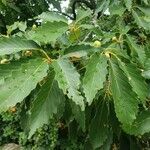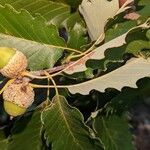Trees , deciduous, moderate to large, to 30 m, occasionally large shrubs (ca. 3 m) on drier sites. Bark gray, thin, flaky to papery. Twigs brownish, 1.5-3(-4) mm diam., sparsely fine-pubescent, soon becoming glabrate, graying in 2d year. Buds brown to red-brown, subrotund to broadly ovoid, 20-40 × (10-)15-25 mm, apex rounded, very sparsely pubescent. Leaves: petiole (7-)10-30(-37) mm. Leaf blade usually obovate, sometimes lanceolate to oblanceolate, (32-)50-150(-210) × (10-)40-80(-106) mm, leathery, base truncate to cuneate, margins regularly undulate, toothed or shallow-lobed, teeth or lobes rounded, or acute-acuminate, often strongly antrorse, secondary veins usually (9-)10-14(-16) on each side, ± parallel, apex short-acute to acuminate or apiculate; surfaces abaxially glaucous or light green, appearing glabrate but with scattered or crowded minute, appressed, symmetric, 6-10-rayed stellate hairs, adaxially lustrous dark green, glabrate. Acorns 1-2, subsessile or on axillary peduncle to 8 mm; cup hemispheric or shallowly cupped, 4-12 mm deep × 8-22 mm wide, enclosing 1/4-1/2 nut, base rounded, margin usually thin, scales closely appressed, moderately to prominently tuberculate, uniformly short gray-pubescent; nut light brown, oblong to ovoid, (13-)15-20(-28) × l0-13(-16) mm. Cotyledons distinct. 2 n = 24.
More
Tall tree (to 25 m) with rather thin, gray, flaky bark; lvs densely pubescent or tomentose beneath with fine, horizontally spreading, grayish hairs, lanceolate to narrowly oblong, oblanceolate or obovate, 10–20 cm, broadly cuneate to rounded at base, with 9–14 veins on each side, the veins running straight to the teeth and nearly parallel, the teeth commonly sharp, ascending, and often incurved, each ending in a minute, papilliform projection; acorns sessile or nearly so, 1–2 cm, the cup 1–2 cm wide, its very numerous small scales free at the tip; nut ovoid. In good, chiefly calcareous soils; Vt. to se. Minn. and w. Nebr., s. to n. Fla., Ala., and Tex. (Q. prinoides var. acuminata)
A medium sized tree. It grows 15-30 m high. It spreads 12 m wide. It is taller if amongst other trees. The trunk is 60 cm across. The trunk is straight and without branches till the crown. It is strongly tapered with a swollen base. The leaves are 10-18 cm long. They are narrow and taper to both ends. They are coarsely toothed. The upper surface is glossy green and it is greyish green and with downy hairs underneath. There are 10-15 straight veins on each side. The leaf stalk is slender and 1-3 cm long. The fruit are acorns which are 12-25 mm long. they have short stalks. The cup is deep and bowl shaped. It covers about one third of the acorn.
Dry calcareous slopes and ridges, or on rich bottoms. Favouring alkaline soils and avoiding acid soils, it grows on limestone outcrops and well-drained slopes of the uplands, usually scattered with other hardwood speciess.
More
It is a temperate plant. It occurs on dry rocky slopes. It is often on limestone soils. It suits hardiness zones 5-9. Arboretum Tasmania.





